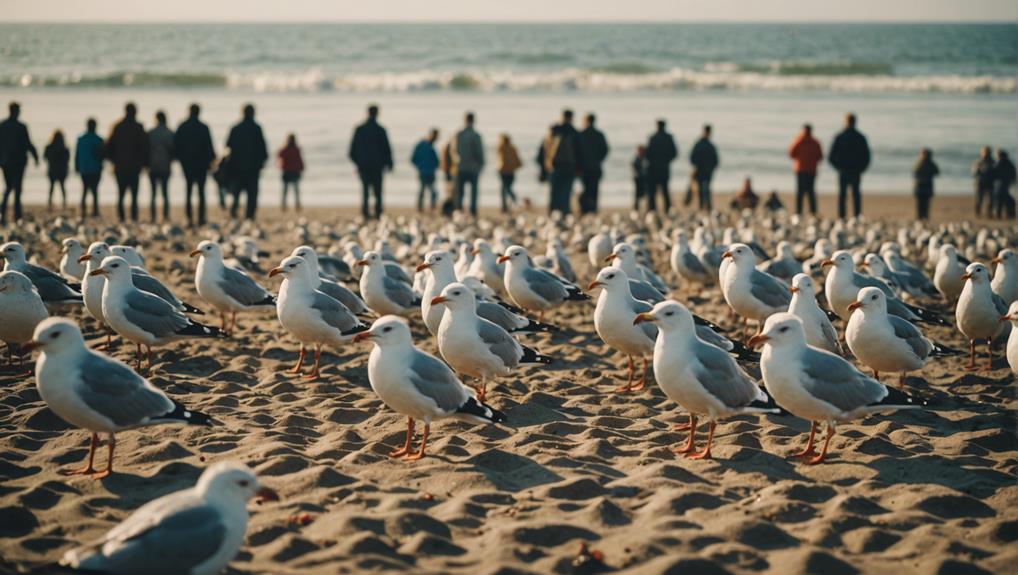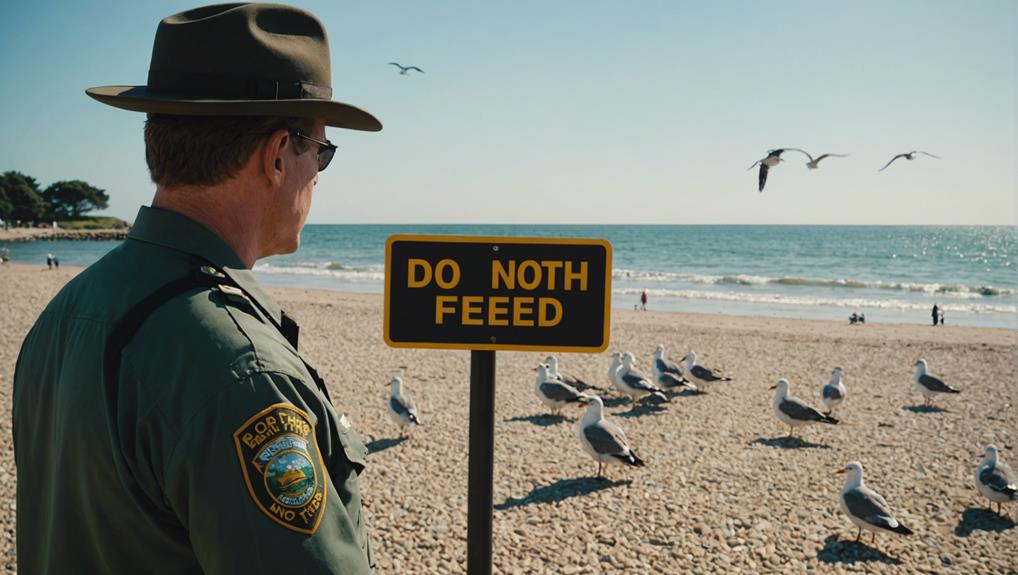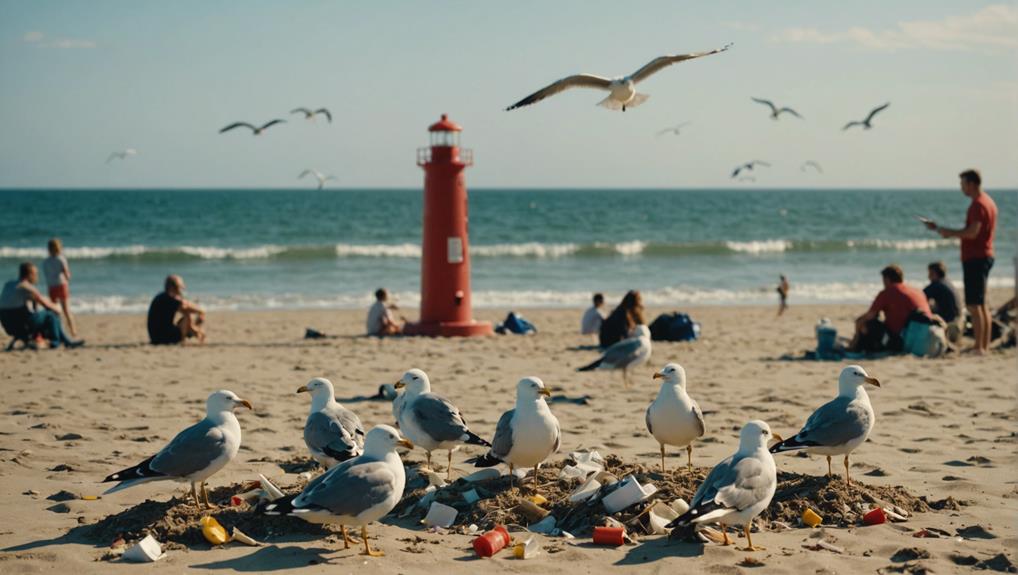Feeding seagulls might seem fun, but it actually harms them. Human food lacks the vital nutrients seagulls need, leading to malnutrition and health problems. It disrupts their natural diet and foraging behaviors, causing dependency on humans and loss of survival skills. Moreover, this feeding can make seagulls more aggressive, creating safety risks in public spaces like beaches and parks. Overpopulation due to easy food sources can upset local ecosystems, and there are often legal consequences for feeding wildlife. Understanding these impacts can help us protect both seagulls and our environment while fostering a safer, more balanced ecosystem. Explore more about the intricate balance of our coastal friends' lives.
Health Risks to Seagulls
Feeding seagulls human foods such as fries and bread can lead to significant health risks due to their absence of important nutrients. When people engage in feeding birds these items, they unintentionally contribute to a range of health problems for the seagulls. Unlike natural food sources that are rich in necessary nutrients, human snacks can cause deficiencies that impact the birds' general well-being.
Seagulls are adapted to a diet that includes fish, insects, and other marine life, which provide the necessary vitamins and minerals for their health. Feeding birds items like bread and fries not only lacks these nutrients but also induces malnutrition. This nutritional imbalance can lead to weakened immune systems, making seagulls more susceptible to diseases.
Moreover, the dependency on human-provided food sources can deter seagulls from foraging for their natural food. This shift in diet can cause more harm than good, as it disrupts their natural feeding habits and diminishes their survival skills.
The long-term effects of consuming inappropriate food can lead to chronic health issues, ultimately shortening their lifespans. Therefore, maintaining a natural diet is important for the health and longevity of seagulls.
Disruption of Natural Diet
The introduction of human foods into the diet of seagulls greatly disrupts their natural foraging patterns and nutritional intake. Feeding behavior teaches gulls to abandon their instinctual methods of hunting for fish, insects, and crustaceans, leading to a significant shift in their dietary habits. This disruption of the natural diet can have a profound impact on health, as human foods like French fries lack the necessary nutrients that seagulls require for best well-being.
When seagulls develop a reliance on human food, their general health deteriorates. A diet high in unhealthy food sources such as processed snacks can lead to malnutrition and other health issues. This reliance not only weakens their physical condition but also diminishes their ability to thrive in their natural habitat. Seagulls become dependent on unhealthy food sources, which can reduce their capability to hunt and survive independently.
Moreover, this shift in dietary behavior disrupts the ecological balance, as seagulls play an important role in their environment. By feeding seagulls human food, we inadvertently interfere with their natural feeding patterns, potentially leading to long-term adverse effects on their populations and the ecosystems they inhabit.
Dependency on Humans

Human intervention in feeding seagulls can foster a significant dependency, stripping them of their natural hunting instincts and vital survival skills. When seagulls regularly rely on humans for food, they gradually lose the ability to source their sustenance in the wild. This dependency on human-provided food creates several significant issues that impact both the seagulls and their environment.
Consider the following points:
- Loss of Natural Hunting Skills: Seagulls are inherently skilled hunters. Feeding them disrupts these instincts, making them less adept at finding natural food sources.
- Nutritional Deficiencies: Human food often lacks necessary nutrients that seagulls need for optimal health. Regular consumption of such food can lead to malnutrition and other health issues.
- Population Imbalance: Continuous feeding can lead to an overpopulation of seagulls in certain areas. This imbalance disrupts local ecosystems, affecting other wildlife and plant life.
Increased Aggression
Encouraging seagulls by providing food can lead to heightened aggression, as these birds begin to associate humans with easy meals. This change in behavior teaches gulls to lurk around popular areas, waiting for the next handout.
Over time, the seagulls become increasingly bold, and even emboldens them to approach people more aggressively when food is not immediately given. This aggressive behavior often manifests in seagulls chasing, pecking, and even stealing food directly from humans.
Such interactions can pose a safety risk, especially in crowded areas like beaches and parks. When seagulls become accustomed to being fed by humans, their natural wariness diminishes, and they can become more persistent and intrusive. This not only creates unpleasant situations for beachgoers but also heightens the potential for injury, particularly to young children who may not be able to fend off an aggressive bird.
To mitigate these risks, it is imperative to stop feeding seagulls. By doing so, we can help reduce their aggressive tendencies and encourage them to revert to their natural foraging behaviors. This will ultimately create a safer and more enjoyable environment for everyone.
Environmental Impact

Frequently feeding seagulls disrupts their natural foraging instincts, thereby impacting the delicate balance of coastal ecosystems. When seagulls rely on human-provided food, their behavior changes, leading to significant environmental consequences. These disruptions can have far-reaching effects that you might not know about.
Altered Behavior: Seagulls that become accustomed to human feeding often exhibit altered behavior, showing increased boldness and aggression. This not only disrupts the natural foraging patterns but also affects their social dynamics, leading to conflicts within their populations.
Overpopulation of Seagulls: Dependence on abundant, easily accessible food sources often results in the overpopulation of seagulls in certain areas. This can lead to increased competition for nesting sites and resources, threatening the survival of other local wildlife species that share the same habitat.
Disruption of the Food Chain: Human interference in the natural diet of seagulls leads to the disruption of the food chain. The seagulls' altered diet can affect their health and the health of the entire ecosystem, as they are key players in coastal food webs.
Understanding these impacts helps us appreciate the importance of maintaining the natural behaviors and interactions of seagulls within their ecosystems, ensuring a healthy and balanced environment.
Attraction of Pests
Feeding seagulls can inadvertently attract other pests, such as rats and pigeons, to the vicinity. When people feed seagulls, leftover food scraps often remain, creating a mess that lures these unwanted pests. Rats and pigeons are particularly drawn to these areas because of the easy access to food. This influx of pests can lead to significant health issues, as both rats and pigeons are known carriers of different diseases.
The presence of these pests results in sanitation issues, as they contribute to an unsanitary environment through their droppings and other waste. Rats, for example, can spread diseases like leptospirosis and hantavirus, while pigeons are known for their role in transmitting illnesses such as histoplasmosis and cryptococcosis.
The accumulation of food scraps, combined with the waste produced by these pests, can quickly transform a clean area into one that is unhygienic and hazardous to public health.
To maintain a healthy and clean environment, it is important to avoid feeding seagulls. By doing so, we can prevent the attraction of pests and mitigate the associated health and sanitation issues. This simple act helps make sure that public spaces remain safe and enjoyable for everyone.
Legal Consequences

Many municipalities have enacted laws prohibiting the feeding of seagulls to mitigate the associated problems. These local laws are designed to address the negative impact of feeding seagulls, which includes issues related to public safety and the well-being of the birds themselves.
Understanding the legal consequences of feeding seagulls is vital for avoiding fines and penalties. Several coastal cities have implemented feeding bans and ordinances to guarantee compliance. Here are three key points to keep in mind:
- Fines and Penalties: Violating feeding bans can result in substantial fines, with amounts varying depending on the specific local laws. These fines serve as a deterrent to prevent individuals from engaging in this harmful practice.
- Public Safety: The legal consequences are in place to safeguard public safety. Feeding seagulls can lead to aggressive behavior, resulting in potential injuries to people, especially in crowded areas like beaches and parks.
- Awareness and Compliance: It's crucial to be aware of and adhere to local laws to avoid legal issues. Public education campaigns often accompany these regulations, helping residents and visitors understand the importance of not feeding seagulls.
Responsible Wildlife Interaction
Critical wildlife interaction is necessary to preserving the natural behaviors and health of seagulls and other coastal species. When we feed gulls, we inadvertently disrupt their natural foraging instincts, which can lead to aggressive behavior and dependency on human-provided food sources. This not only affects one gull but can have broader negative consequences for the entire coastal ecosystem.
Knowing the impact of feeding wild animals is important for anyone who spends time near the coast. Seagulls, like all wild animals, have evolved to hunt for natural prey. Human interference through feeding can cause them to lose these crucial skills, ultimately impacting their overall health and survival. Over time, seagulls may become reliant on food from humans, which is often nutritionally inadequate and can lead to different health issues.
Responsible wildlife interaction means refraining from feeding seagulls to maintain a balanced ecosystem. By allowing gulls to engage in their natural behaviors, we support not only their well-being but also that of other coastal species. It is vital to appreciate and respect wild animals, ensuring minimal human interference to preserve the intricate balance of our natural environment.
Frequently Asked Questions
Is It Okay to Feed Seagulls on the Beach?
Feeding seagulls on the beach is not advisable. While it might seem harmless or fun, it can lead to several issues.
Seagulls can become aggressive, expecting food from humans. Moreover, human food lacks vital nutrients for them and disturbs their natural diet. Over time, they may lose their natural foraging skills, becoming dependent on human-provided food.
Furthermore, it can attract large numbers of seagulls, creating a nuisance for beachgoers.
Is It Legal to Feed Seagulls?
The legality of feeding seagulls varies by location, so it's important to check local regulations before doing so. Many coastal areas have enacted laws against feeding seagulls to protect the environment and public safety. Violations can result in fines or penalties.
These measures aim to preserve the ecosystem and prevent aggressive bird behavior. Always make sure you are aware of and comply with local laws to avoid legal consequences.
How Do I Stop People From Feeding Seagulls?
To stop people from feeding seagulls, one effective strategy is to clearly post signs in public spaces explaining the negative impacts. These signs can help educate the community about the consequences of feeding seagulls, such as disrupting their natural behaviors and potentially causing aggression.
Another important step is to implement outreach programs that focus on educating the public about the dangers of feeding seagulls. These programs can help raise awareness and encourage proper disposal of food waste to minimize opportunities for scavenging.
Collaborating with local authorities to enforce regulations and impose fines on those who ignore warnings is crucial. By working together with authorities, it becomes possible to create a system that effectively deters people from engaging in the harmful practice of feeding seagulls.
Are Seagulls Good for the Environment?
Seagulls play an important role in the environment by controlling populations of smaller birds, eggs, and chicks, thereby maintaining ecological balance.
Their adaptability allows them to thrive in diverse habitats, including polluted areas and alongside humans.
In North America, species like the American herring gull and Great Black-backed Gull are prevalent.
Understanding their ecological contributions and adaptations is vital for effective conservation efforts, ensuring healthy coastal ecosystems.

